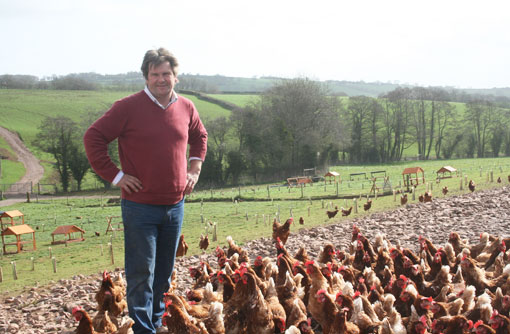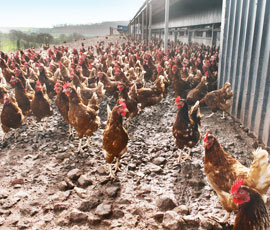Efficiency gains from multi-tier

Attention to detail counts for everything when it comes to multi-tier, as Poultry World discovers.
Measuring feed intake and minimising wastage are two crucial aspects of management for Herefordshire free-range egg producers, Paul and Pippa Hale.
With a 16,000 bird multi-tier unit, the Hales are relatively new to free-range poultry, taking delivery of their first flock in 2009.
The most recent flock was still producing at 90% at 60 weeks, having peaked at 96%, a testament to their hard work, attention to detail and the utilisation of new technology.
“The decision to construct a multi-tier system was taken about three years ago,” says Mr Hale. “We certainly did our homework, having looked first at various free-range systems and decided that multi-tier suited our requirements and business objectives and that the extra investment would certainly be worth it in the long term.”
All free-range businesses have been affected by high feed costs and the over-supplied egg market. However, being a “young” poultry business also brings certain benefits, says Mr Hale.
“As a result of the extra investment, we have a highly efficient poultry house that is fully insulated, easy to manage and utilises best available technology. This gives our business an advantage compared to, say, a free-range unit with a 20-year-old shed.
“We invested wisely. But it’s impossible to be completely protected from market volatility; nobody could have forecast the price of wheat doubling in such a short space of time, or that retailers would not respond to that rise, and if egg prices continue as they are then the future remains very uncertain for the industry at large.”
Feed efficiency
The focus is on high productivity and feed efficiency. “We have two feed bins, giving us a total capacity of 36t. Each bin has four legs and each leg is on a load cell which feeds information back to the central computer, allowing for detailed monitoring of feed usage.
 “The computer weighs the bins each day and then divides that figure by the number of birds. The flock currently operates at between 120-130g of feed per bird per day and I am always looking to improve the feed efficiency of the flock.”
“The computer weighs the bins each day and then divides that figure by the number of birds. The flock currently operates at between 120-130g of feed per bird per day and I am always looking to improve the feed efficiency of the flock.”
Anthony Harman, poultry specialist with Humphrey Feeds, visits the Hales on a weekly basis. “Many free-range producers will not have access to these figures, yet in the current climate measuring feed intake is a vital indicator of performance, while giving the ability to know and control the key input cost.
“Without automated modern technology, it can take weeks before noticing the birds are not eating as they should and, with feed at 60-65% of total outgoing costs, feed efficiency is a crucial area that producers have to get right.”
Feed is delivered once a fortnight by a 27t articulated lorry. “We decided to invest in bigger bins to increase delivery size and reduce the frequency of feed deliveries, plus it’s a more cost effective way to buy feed; payback on the investment will be realised within a year.”
Minimising feed wastage is also high on Mr Hale’s agenda. “Our chain feeders are designed to reduce wastage and, although the feed lines are automated, I do continue to check them on a regular basis. Often I will shut off certain lines to ensure the birds are eating everything from the track. I also set the times to feed, which is flock specific. But as a general rule, I aim to feed the birds about half an hour after they wake up. This avoids any disturbance whilst the birds are in the nest boxes.”
Stocking density
Vertical LED rope lights reduce shadows while lighting all levels of the shed evenly. The temperature is kept at 20C, which varies slightly when the pop holes are opened. However, fresh air coming through the shed is essential.
“The other major advantage of a multi-tier system is that it allows for optimal bird numbers,” says Mr Hale. “Stocking density legislation of 9 birds/sq m applies slightly differently to multi-tier, as the birds are housed on a number of levels, therefore it’s a more economic and efficient way of free-range farming.”
For this reason, there is some public opposition to multi-tier housing. But Mr Hale says this is due to a lack of understanding of chickens and what they require.
“In my experience, the birds enjoy moving around the multi-tier system so are happy in the shed, and are equally happy to go out on the range. I open the pop holes early in the day, at around 9am, to encourage ranging, plus I ensure there are plenty of cover trees on the range.
“How free-range farming is perceived as very important and promoting the benefits of multi-tier egg production, both within and outside the industry, is vital in my opinion. I have had many visitors here, including 20-year poultrymen who are well respected farmers, many of whom commented on how fit and healthy the birds look.”
Pullet rearing
“A key factor for multi-tier producers is to ensure you have like for like pullets,” says Mr Harman, who also works with Humphrey Pullets. “If the birds are not multi-tier reared, the transition to the laying farm is certainly not as efficient. Pullets ideally need to build strength in their legs and wings on a like-for-like multi-tier system, rather than a standard jump system.
 “When the birds do arrive, you soon notice the bully birds; within a week you can see the strong birds go high and the weaker stay low. As a result, feed tracks are situated at two heights, which removes almost all bullying and feather pecking.”
“When the birds do arrive, you soon notice the bully birds; within a week you can see the strong birds go high and the weaker stay low. As a result, feed tracks are situated at two heights, which removes almost all bullying and feather pecking.”
Mr Hale agrees that the system works well. “The shed is smaller, so easier to manage and, apart from two wooden seams running through the shed, is made entirely of steel. As a result, it is easier to clean and wash down, disease burden and labour requirements are less and flock turnaround much quicker.
“The other major benefit over conventional free range is that you are not keeping the birds over a pit of muck. The muck is cleared out on a track system every four days. It is removed on belts that run the full length of the tier, to the back of the shed where it drops onto a quarry belt, up an elevated system and outside into a waiting trailer or muck spreader.
“As a result we have not had a fly problem on farm. This was particularly evident last summer, where eggs from other farms were rejected due to fly muck – we had absolutely no such problems.”
An unlikely diversification
As well as the hens and 100 beef cattle, the Hales run a successful diversification business selling canoes and kayaks. “Nearly five years ago we took the decision to stop milking cows and focus on selling canoes and kayaks,” explains Pippa Hale.
“People thought we were mad, as the farm is practically on the top of a hill. We converted the old pig shed into a shop and have steadily grown the business, which is now one of the biggest in the country. We have subsequently built a lake on site for customers to try the canoes, plus we offer camping and caravanning.”
Symonds Yat, which is a popular canoeing spot on the River Wye, is just seven miles away.
“Sales from both the shop and the corresponding website are good and we employ one full-time and one part-time member of staff. I admit it was a risk, but one that has certainly paid off. We wanted to operate in both the food and leisure sectors, as we believe even in difficult economic times the general public will continue to spend money on food and on leisure pursuits.”
Farm facts
• 16,000 free-range birds, Lohmann Browns
• Noble egg producer
• Multi-tier house and Hotraco Orion Computer System – PW Maines
• Pullets supplied by Janssen
